This month’s newsletter has been put together in the most mismatched of ways; during layovers in Switzerland, in notes on my phone on the bus/train/runway/lying in a bath, and of course, mostly, propped up in bed, in my t-shirt and pants with a strong coffee and my laptop, not quite ready to face the furor of the day. It is in these moments that I ever so slightly regret publicly announcing my plans to write, or my promise of a publishing date by the end(ish) of each month. But of course, these things keep us honest, so thanks to all of you subscribers for unconsciously keeping me in check!
When this finally lands into your inboxes, I shall be swanning (in a Flix bus, no less) over the French-Spanish border, heading to the little known city of Barcelona. This feels quite illustrative of the slightly chaotic, forward motion of this past month and the slightly unnerving yet exciting energy of spinning many plates. It feels like living in a long restaurant service where you’re in the shit and there is that underlying sense that, whilst you may just be nailing it, the wheels could really come off at any moment. But as a former child of hospo, I think there is a part of me that still likes to lean into the rush and that nervy sense of possibility (read: chaos). So here I am, en route to spend a week in Spain where I’ll be travelling from Barcelona to Málaga to host the inaugural Fire & Wine long lunch pop-up with my good friend and top notch chef, Paddy Wardell. Vamos!
Alsace; lessons in authenticity
I am not sure if this is the same for any of you but when I am living in these moments that are stimulus-heavy - new environments, new people, new foods and wines, late nights and early mornings - my senses can become a little overloaded. However, in spite of this tiny little violin I am playing here, when the charisma of a place and a culture still manage to permeate all the fat (literally in this case), then I can’t help but pay attention. And in this case, that charismatic place just happens to be the little sliver of France that is Alsace.
This was my first ever visit to the region - we stayed in the very wine-y town of Dambach-la-Ville to be exact - and really, honestly, I fell for its total originality and coolness, and its seeming nonchalance for the trends going on around it. Now, I feel I should caveat what I mean by cool because it's definitely not Marseilles cool, it's not Cap Ferret cool, it's not Auberge de Chassignolles cool. It is a type of cool I didn’t even really know I wanted; sitting on a different planet entirely to the world of small plates, natty wine and irreverent servers that seem almost ubiquitously cool now. Being here felt like I had stepped back in time to somewhere in the late 70s - early 80s, perhaps right into the pages of a Jilly Cooper novel. If I had stumbled across some naked tennis à la Rivals, I wouldn’t have at all been shocked.


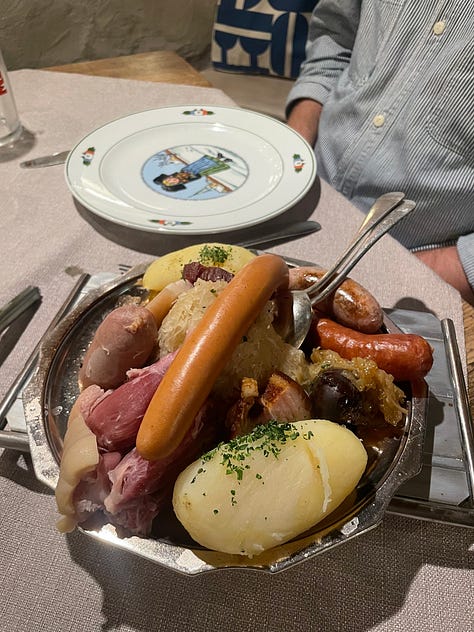
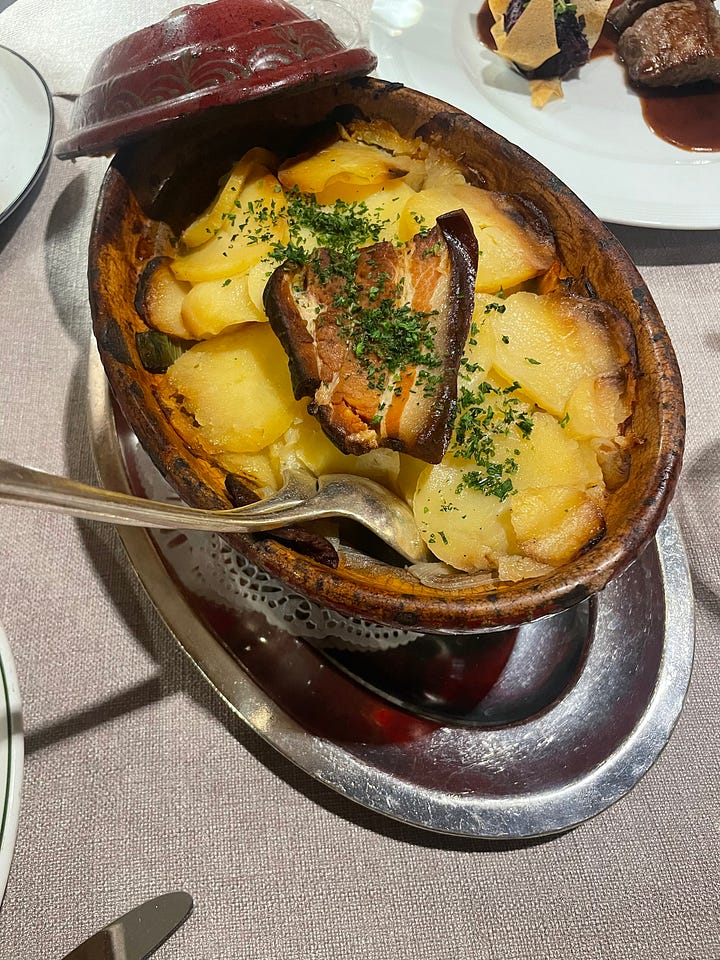

The village of Dambach itself seems almost sepia-toned with the thick wooden beams and walls painted hues of peach, brown and yellow. The carpets are shaggy and the decor and crockery are so very kitsch. During one particular lunch, I noticed a mannequin dressed in lederhosen and a Santa hat propped up in the centre of the room. No rhyme or reason, but for me, this just sums up the big D energy of Alsace. The food is also unapologetically Alsatian. And when I say that, I mean it is meat and sauerkraut in different variations and in very generous portions. When I queried what vegetables were served, the response was sauerkraut and potatoes. Fair. Very fair. Oh, and I feel I should mention that the wine is ridiculously delicious and affordable. Their real focus is white wines and they’re top notch stuff - the Grand Cru wines - can easily be drunk in a restaurant for sub-€40. Pricing that definitely feels like a relic from the past.
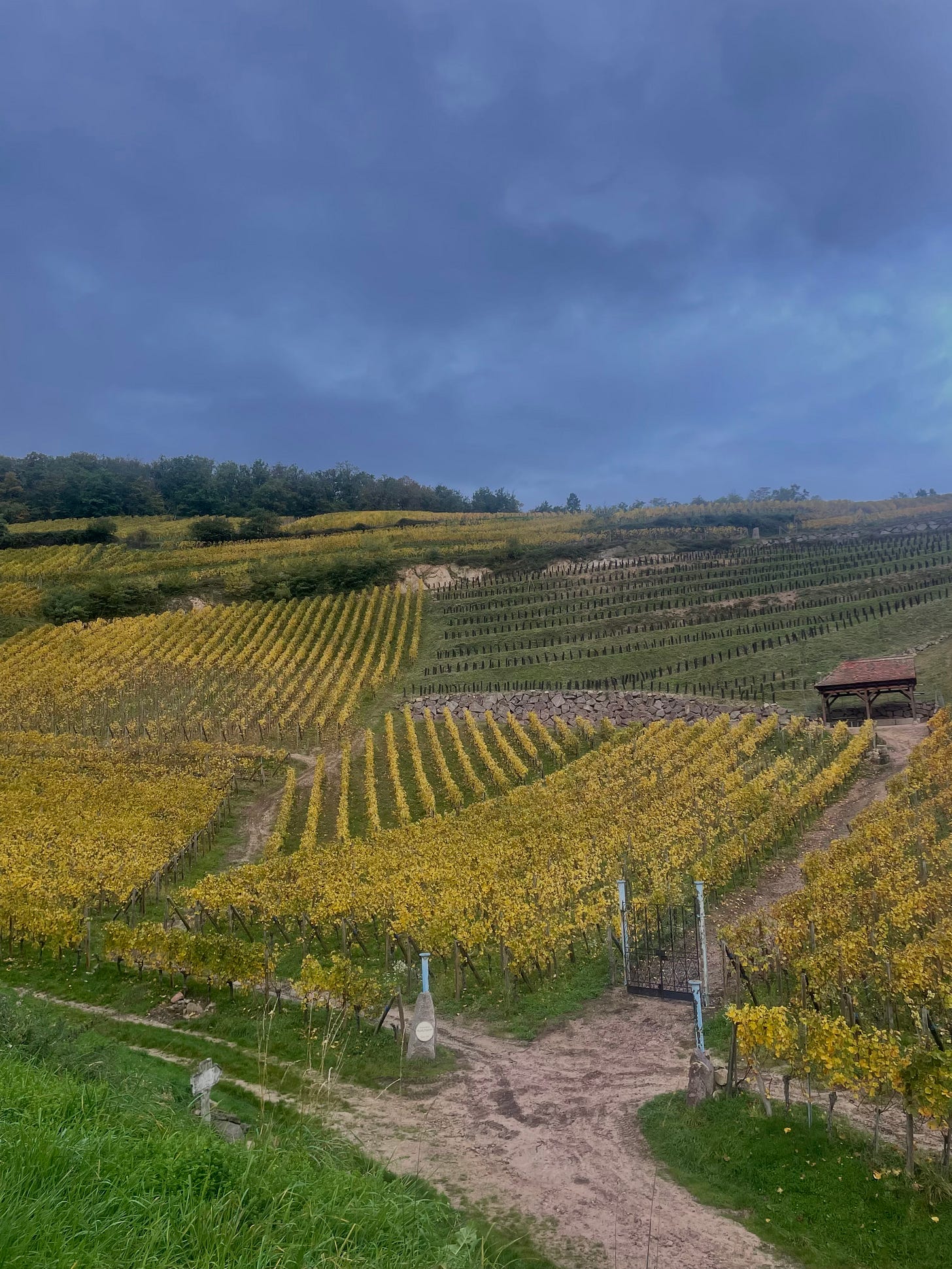
For some reason, the whole experience made me think of an over-therapised ex of mine who was obsessed with the “authentic self.” I am sure that he would be very happy to know that this little pocket of France is a mecca of authenticity that holds steadfast to its own version of food, wine, decor and ambiance. Ultimately, Alsace achieves its coolness through its authenticity, without the hefty therapy bill.
My top tips for living with some of that big Alsatian energy:
Tradition is everything, so if you’re drinking, it should be in the trad Alsatian green stemmed glassware, and if you’re eating, be it from OG Alsatian pottery village of Soufflenheim.
Meat is in. In fact, multiple meats at the same time is preferred. Try the nine meat Choucroute Garnie or the three meat Baeckeoffe.
On either side of your meat mountain, you should be indulging in creamy pleasures; kick off with cream and lardon topped Alsatian pizza known as Flammekueche and finish with crème brûlée.
It is all about white wine and meat. Really trust me on this one - your digestion will thank me.
If for some reason you think your body may struggle after such a glutinous pounding, I suggest a local damson eau de vie. Damson is known locally as Prune d’Alsace.


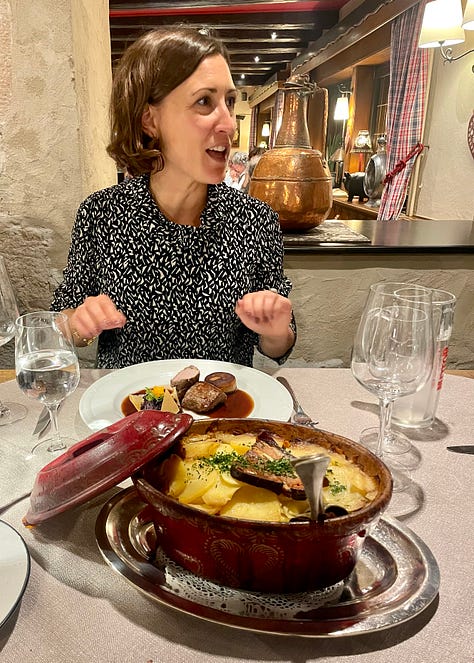
A dalliance with the unknown; my favourite alternative grape varieties
Whilst Alsace is getting a lot of love this month, I should probably mention that I also travelled to Burgundy, where I got to work with the wonderful Hautes-Côtes team and their VinHipHop mega party at the 12th century Clos de Vougeot. Naturally, this was an epic celebration of Hip Hop and two of the most highly lauded grape varieties in the world; Chardonnay and Pinot Noir. The experience was a pitch-perfect window in the adaptability and deliciousness of a region that manages to harness tradition and forward-motion so seamlessly.
However, my subsequent travels through Alsace and Portugal made me painfully aware of how many indigenous and unique grapes there are in the world, who live in the shadow of their more famous cousins. Whilst there are said to be thousands of grape varieties out there, we only really consume about ten of these, of which the majority originate from France: Chardonnay, Sauvignon Blanc, Merlot and Cabernet Sauvignon being amongst the most dominant.
A perfect storm of consumer demand, history, marketing, money and volume-led farming has seen the near extinction of many grapes in favour of higher yielding, recognisable varieties. Next time you’re in the supermarket, take a look at how the wine shelves are split; you’ll see that New Zealand Sauvignon Blanc will receive perhaps triple the space of a handful of other regions representing a whole host of grape varieties.
I think that we can all agree that homogenisation in any realm is a sad future, and without sounding like your pious aunt, variety really is the spice of life. So, perhaps if you’re wanting to just do something a little bit differently this month, I propose having a dalliance with a grape you’ve perhaps never had before. From my travels this month, here is a round-up of some of my most cherished alternative white grape varieties:
Arinto - Five years ago, I spent a wonderful, romance-filled 6 months in Portugal. I hit the road with a very persuasive and tattooed French man to do harvest all over the country, starting in Lisbon and ending in the tiny, almost forgotten town of Uva (aptly named, I know) on the precipice of the Spanish border. This trip was a revelation for me in regards to the quality, originality and breadth of Portuguese wine. Britain and Portugal have strong historical ties when it comes to wine - the proof of which can still be seen in the proliferation of Port in the homes and restaurants across the British Isles. This is a very long-winded way of telling you that there is a lot more out there than Port, including the local Arinto. This is a mineral, fresh variety that has notes of lemon and grapefruit and with age, a moreish nuttiness. A great alternative to a Chablis.
Try - Vale da Capucha Branco Blend 2018, Lisbon
Rabo de Ovelha - This month marked the first time since that fateful trip that I had travelled back to Portugal and to spend time with the winemakers that taught me so much many moons ago. And true to form, I was once again the student as Tiago Teles introduced me to a grape I had never even heard of, let alone tasted. It literally translates as “sheep’s ass” but I am almost certain that the taste differs. This grape offers up something dense and textured, with the propensity to take the place of a more full-bodied chardonnay.
Try - Cozs Pop Rabo de Ovelha 2022, Lisbon - should probably mention that this is only available in Portugal but hey, when in Lisbon!
Auxerrois - Perhaps a little pronunciation lesson is handy to kick off proceedings - ORX-SER-WAH. This Alsatian trip was a reacquainting with this grape. It had sat somewhere in the periphery of my WSET knowledge (the wine education that a lot of us do) but hadn’t made too much of an appearance apart from that. It is related to Pinot Noir and genetic testing suggests it is a sibling of Chardonnay, which isn’t too shabby in terms of lineage. The grape is favoured for bringing body and spice and does well with a bit of barrel ageing. Good to note it is often blended with Pinot Blanc and/or Riesling.
Try - Domaine Marcel Deiss Zellenberg 2022, Alsace
Timorasso - an everlasting love of mine that was a favoured and successful tool when still working as a sommelier. This Piedmontese native was almost extinct by the 1980s but was thankfully revived by the eccentric Walter Massa of Vigneti Massa. And whilst there are surely other great iterations, Walter’s Timorasso is so sublime, with plump texture, earthy minerality and an ethereal sex appeal that it remains my go-to. I apologise in advance for this, but it really is excellent with white truffle. Failing white truffle, normal truffle will suffice.
Try - Vigneti Massa Derthona Timorasso 2020, Piedmont
Thanks so much for reading, all of you darling crumpets. And as much as the words “authentic self” used to make my skin crawl, I think Alsace has managed to take the ick out of these words and give them a new lease of life. So may we all live with a little bit of that big Alsatian energy and have the nerve to go against the grain and do what feels good for us x
P.s I had the joy of spending a few hours with Lawrence Francis for his podcast Interpreting Wine last week and am excited to let you know that the episode will be dropped at the end of this month. Give him a follow on insta or spotify to listen!

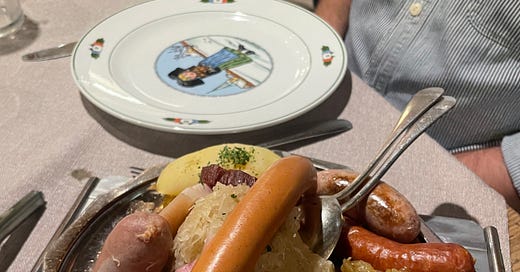


Great read. Alsace sounds like the land of comfort food in abundance - will have to book flights asap!